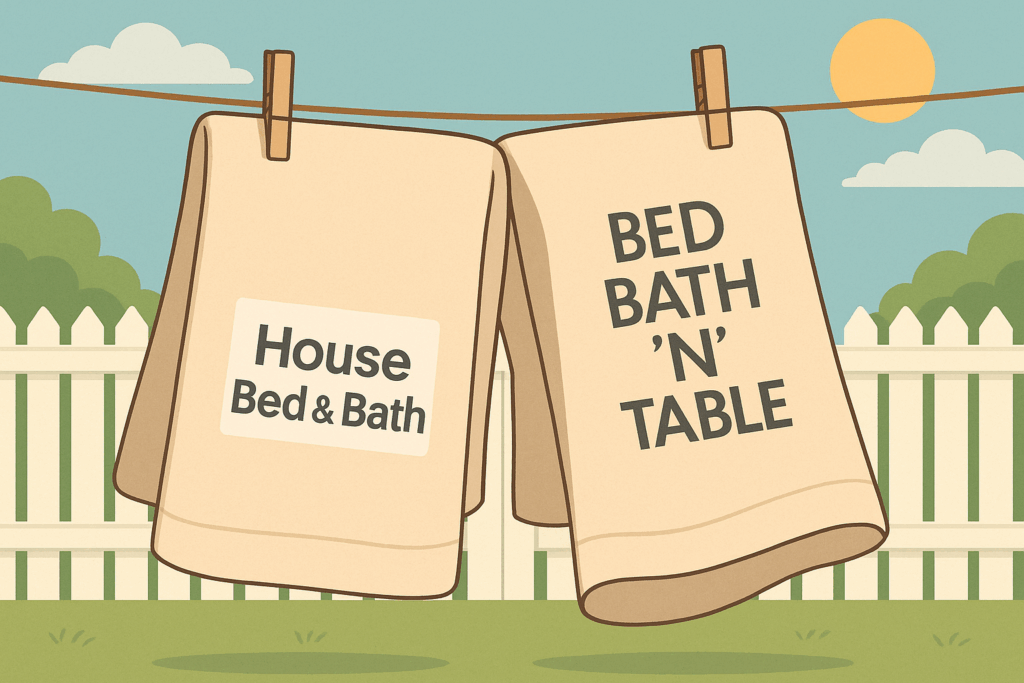What happens when your new brand smells a little too much like the towels next door? (High Court Edition)
 The linen wars have gone all the way to the top.
The linen wars have gone all the way to the top.
Earlier this year, we wrote about Global Retail Brands Australia (GRBA) — the team behind House and its spin-off House Bed & Bath — squaring off against soft-homewares stalwart Bed Bath ‘N’ Table (BBNT). The Federal Court split the baby: no trade mark infringement (the marks weren’t deceptively similar), but misleading conduct and passing off were found at first instance. The Full Federal Court overturned those latter findings, giving GRBA a win.
Now, the High Court has heard the appeal, reserved its decision, and the case is poised to reshape the way Australian law balances trade mark rights, reputation, and consumer protection.
The clash of frameworks: trade mark vs consumer law
At the heart of the battle is the distinction sharpened by the High Court in Self Care v Allergan (2023).
-
Trade mark infringement under the Trade Marks Act 1995 (Cth) is an artificial “mark-on-mark” comparison, stripped of reputation, history, and context.
-
Misleading and deceptive conduct under the ACL (and passing off) is broader, taking in the real-world reputation of the trader, the marketplace, and consumer impressions.
BBNT argues the Full Federal Court collapsed the distinction by effectively treating the failure on the trade mark claim as the “starting point” for rejecting the ACL/passing off claims. In its view, that’s a methodological error: reputation and consumer context should drive the ACL analysis.
GRBA counters that there were “substantial and crucial differences” between House Bed & Bath and Bed Bath ‘N’ Table, and — critically — that BBNT had no independent reputation in Bed & Bath alone. Any risk of confusion, they say, was theoretical at best.
Inside the High Court hearing
The transcript gives a flavour of the tension. Counsel for BBNT pressed that the proper inquiry under the ACL was not whether the marks looked deceptively similar in the abstract, but what meaning a reasonable consumer would take in light of BBNT’s 40 years of unique use of Bed Bath ‘N’ Table in the soft-homewares market. Add GRBA’s adoption of a Hamptons-style fit-out, similar typography, and the deliberate choice of “Bed & Bath” over alternatives like House Bath & Bed or House Bedworks, and the picture (they say) becomes clear.
GRBA, in response, stressed that “House” dominates their brand and that consumers couldn’t miss it “save through exceptional carelessness or stupidity” (yes, that’s the phrase from the Full Court). They emphasised that BBNT’s reputation rested in the whole composite mark — Bed Bath ‘N’ Table — not the sliced-off “Bed & Bath” segment.
The bigger questions
The case raises issues far beyond duvets and towels:
-
Can reputation in a composite mark give effective monopoly over common category words? BBNT says yes, at least where decades of unique use have entrenched association. GRBA says no — descriptive words like “bed” and “bath” can’t be locked up, even after 40 years.
-
Does “wilful blindness” matter? The primary judge thought GRBA’s conduct (and evidence of strategic borrowing) was “fitted for the purpose” of diverting trade. The Full Court disagreed, saying sharp elbows in commerce don’t necessarily equal deception.
-
Where do trade mark law and the ACL intersect? The High Court is being asked to clarify whether a finding of no trade mark infringement makes it harder — or irrelevant — to succeed under consumer law.
Why it matters
For retailers and brand advisors, this case could reset the boundaries between:
-
Protectable brand equity and the freedom to use descriptive terms;
-
Strategic mimicry and unlawful deception;
-
The narrow lens of statutory trade mark rights and the broader sweep of consumer expectations.
If the High Court restores the primary judge’s finding for BBNT, it could embolden established brands to take action even where marks aren’t deceptively similar, so long as the marketplace context points to deception. If it affirms the Full Court, it will signal that descriptive terms are fair game, and that reputation in a composite mark doesn’t easily fracture into enforceable monopolies over its parts.
Final thoughts
The towels are still fluffed, the pillows puffed, and the decision is pending.
Whichever way the High Court turns, this case will be cited in branding disputes for years. It’s a live stress test of how Australia draws the line between brand mimicry and market misconduct.
And for those keeping track of timing, yes — the Court has reserved. Whether judgment arrives by Towel Day next year remains to be seen.
👉 We’ll update when the High Court finally beds down its answer. Until then, trade mark lawyers and brand managers should keep one eye on Doncaster and Chadstone… and the other on the High Court bench.